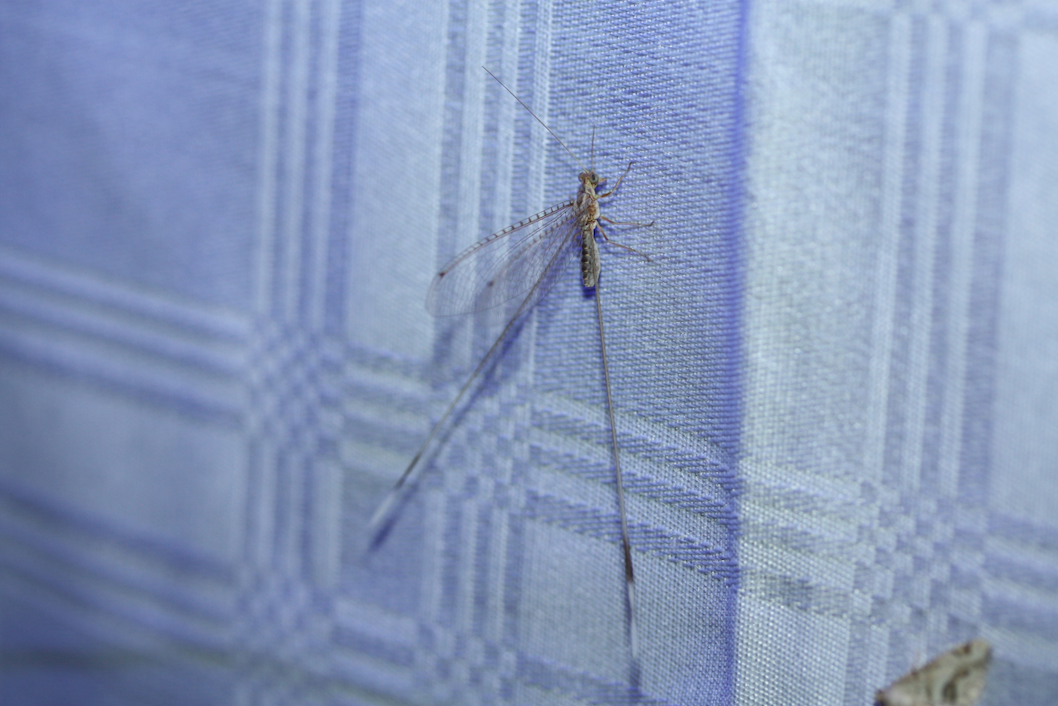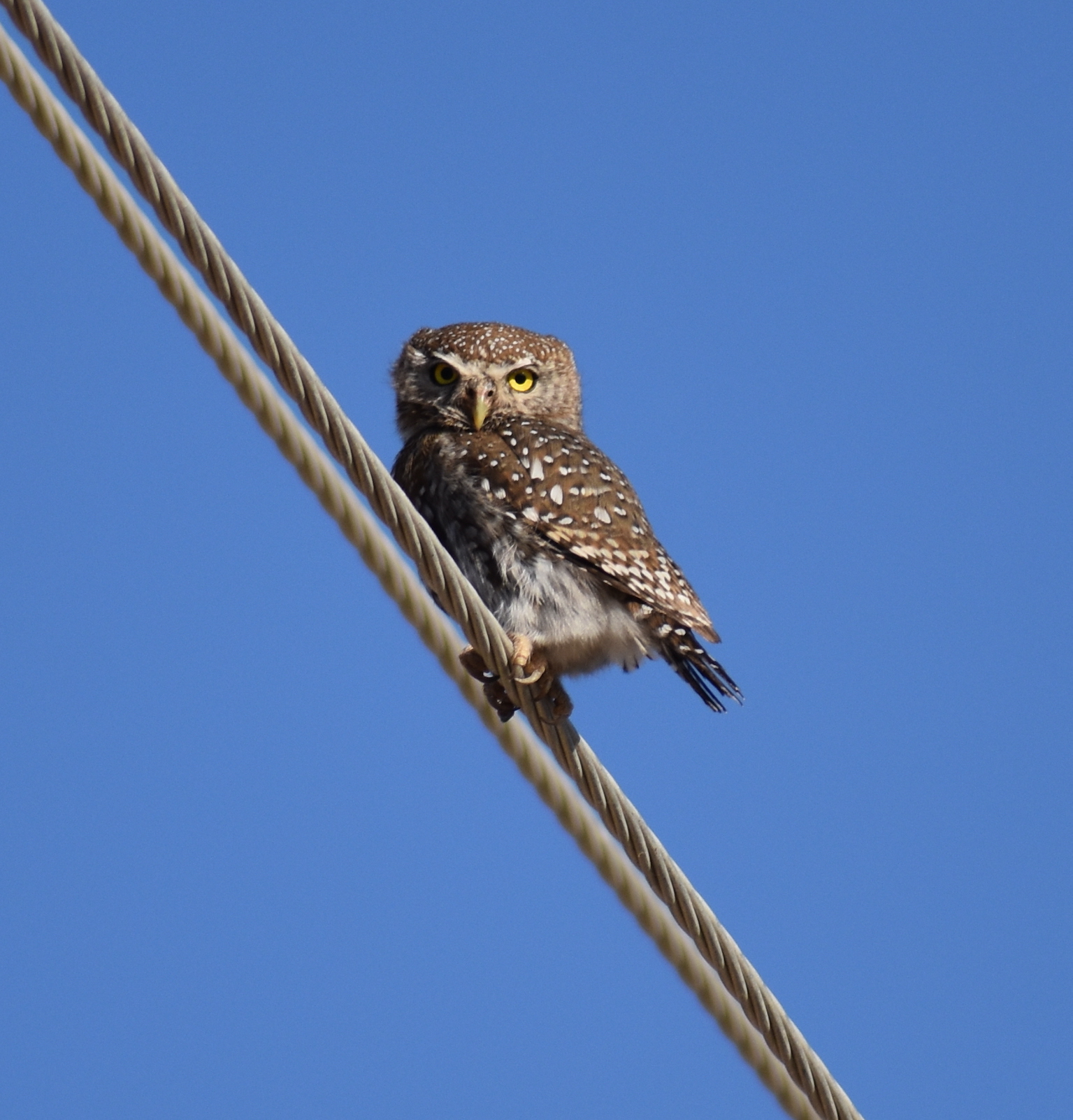The interface of Kalahari and Karoo is a study in contrasts: red sands and blue skies; dry earth and flowing river; bustling weaver colonies and deserted towns. My first week of October was spent participating in a BioBash in this dynamic region of the world, collecting Virtual Museum (VM) records alongside a team led by Altha Liebenberg and Salome Willemse. (If you are unfamiliar with the concept of a BioBash, this blog post explains our previous trip to the Northern Cape.) Apart from our fearless leaders, the team was comprised of myself, Hardy and Joey Herbst, Alan Lee, Stefan Theron, and Les Underhill.
In April 2019, citizen scientist Altha Liebenberg hatched a plan for a BioBash at Boegoeberg dam, a campsite-turned-resort alongside the Orange River in the Northern Cape. Tucked away on a gravel road between Groblershoop to the North and Prieska to the South, Boegoeberg occupies a unique biological niche. A variety of ecosystems meet and merge here: Kalahari Scrub-robin, towards the southern reaches of its range, forage alongside Karoo Scrub-robin, near the northern end of its range, and riparian species such as Goliath Heron glide along the river.
The convergence of these three worlds creates a fascinating and complex playground of exploration for the curious biologist…and explore we did! Over the course of four days, Salome and I worked through seven quarter-degree grid cells (QDGCs) as well as our “home” grid cell.
A personal highlight for me occurred on our second full day, Oct. 2, when we stumbled upon Putsonderwater, an abandoned settlement 65 km southwest of Boegoeberg. Situated along a railway line between De Aar and Upington, the station-town formed in the 1800’s and enjoyed a brief but bustling history. Today, however, the settlement is devoid of life, eerie and beautiful.

Tentative trees poke branches through broken floorboards, and hallways display windblown carpets of red sand. It is deafeningly quiet; only a dusty wind, and the occasional rustle of feathers as a Rock Martin swoops past. Colourful cacti creep across the barren ground.


On the edges of the settlement, long-discontinued telephone poles wear heavy straw hats: massive nests, masterfully crafted by resident Sociable Weaver colonies. These remarkable birds are endemic to southern Africa and build the largest nests of any avian species. Their handiwork quickly became a familiar sight, whether draped over old trees or topping endless lines of poles.

After half an hour spent peering through windowless frames and wandering unroofed halls, we chose to explore a few of the surrounding buildings in search of more life. Our efforts yielded unexpected findings: a pair of Spotted Eagle-Owls peering down from a pine, and Red-veined Darters hovering above bone-dry perches. This Red-veined Darter was the first photographic record for the entire quarter-degree grid cell, 2921BD—for any VM project!
The surprises continued, as rusty sheets of metal and old bricks revealed Bibron’s Thick-toed Gecko and Spotted Sand Lizard.
Our afternoon in Putsonderwater ultimately concluded with fifteen species added to BirdPix, two for ReptileMAP, a Brown-Veined White for LepiMAP, and a new Steenbok record for MammalMAP–and we claimed the added satisfaction of acquainting ourselves with the mystery that is Putsonderwater.

Though most days were spent working in the pentads and grid cells surrounding Boegoeberg, we did take time to explore our “home” grid cell as well. In addition to camping facilities, Boegoeberg Dam also offers canoes and kayaks for use on the dam. Early Thursday morning, Salome and I hoped to take a canoe out onto the water to search for a few more riparian species…blissfully unaware that Thursday had other plans. Before dawn, we awoke to the unique sensation of wind violently shaking our tent—wind strong enough, we surmised, to deposit us in Marydale, the next town along the Orange River! Needless to say, we avoided canoes for the day, instead lacing up our hiking boots and tackling two trails running alongside the dam. In spite of the wind, these trails were bursting with life.

A short scramble and walk led us to a large patch of reeds beside the river. Along the route, we were treated to a beautiful sighting of this Pearl-spotted Owlet, whose mournful song carried across our campsite each night.
Once we reached the river, it was difficult to hear anything over the noisy gurgle of water pouring in from the canal to our left. Still, as is so often the case when in nature, a few minutes of patience paid off. We were soon rewarded with sightings of African Reed Warbler, White-rumped Swift, White-throated Swallow, Southern Masked-weaver, Reed Cormorant, White-breasted Cormorant, and Orange River White-eye.
We found treasures closer to the campsite, as well—as darkness settled over the tents, Altha set up a blacklight to attract moths and lacewings. This is one of her three resulting submissions to LacewingMAP, a beautiful female Nemopterella species.

During the day, dozens of Brown-veined Whites danced through the sunlight-speckled shade alongside the dam, clustering together to drink from shallow pools of water.
It was the mammals, though, which undoubtedly left the strongest impression; in particular, the resident population of vervet monkeys. Endlessly curious and ever-resourceful, these clever critters ventured into our tents not once, but twice! This especially cheeky individual made off with a rusk, and perched atop one of our tents whilst polishing it off.

With the exception of the vervet monkeys, other mammals kept a wary distance. Slender mongoose and South African ground squirrel scurried across pathways, and though we spotted baboons a few times (and certainly heard them in the morning), they stayed clear of the campsite.
This trip is, in my mind, accompanied by an overwhelming sense of gratitude; my story is only one among many. Whether by foot, bike, canoe, or bakkie, Alan and Stefan worked as a team, tackling difficult pentads for the South African Bird Atlas Project (SABAP2). Though their quest for birds (and penchant for 50 species per pentad) led them across some unusual terrain, it also saw them welcomed into homes for meals and conversation. Altha, Hardy, and Joey focussed their energies on Boegoeberg dam, taking route recommendations from Magda, the dynamic driving force behind much of the campsite’s restoration. Together, these three scoured walking and driving routes along the water’s edge and the canal in search of birds, butterflies, reptiles, and more to build the species list for the grid cell. Les visited some of the furthest locations from the campsite, following the river and adding valuable riparian species records to the grid cells.

Beyond those of us immediately involved in data collection, the trip itself was made possible by dozens of generous sponsors in Danielskuil. Our sponsors supplied fresh fruit, cool drinks, and gear to fuel our journeys, and Boegoeberg Dam itself generously provided our tents and sleeping cots. And, of course, what BioBash would be complete without a large-scale “battle plan” map? Though unable to attend in person, Tino Herselman created beautiful, detailed maps of the region for each participant to use during the week.

Each individual contribution made our BioBash not only possible, but successful. We added Virtual Museum records to 10 QDGCs, and covered 23 pentads for SABAP2. Though ID’s for many of the Lepidopteran species and a few reptiles are still pending, one look at the BirdPix data speaks volumes.

The map on the left shows BirdPix coverage in the Northern Cape prior to our trip, in number of species recorded per QDGC. Boegoeberg Dam is located at 2922AA, and contains 30 species. The map on the right was created on October 15th, and the increase in that grid cell alone is astounding—83 species records! The surrounding cells also show significant improvements.
Once again, I am amazed at the difference a few dedicated individuals can make within such a short period of time. Thank you to all of the sponsors, participants, and contributors who made Boegoeberg BioBash 2019 possible—we are so thankful to have you on our team! To readers and citizen scientists who may not have ventured into this part of the Northern Cape, I encourage considering a visit to Boegoeberg. There are few facilities in this region which offer accommodation alongside such a unique diversity of wildlife, and your stay will be made all the more memorable by the warm welcome you receive. I hope that you are able to experience Boegoeberg for yourselves, and find your own adventures in this remarkable part of the world.
Further reading for the curious mind. An interesting write-up on the history of Putsonderwater can be found here: https://mg.co.za/article/2009-08-05-putsonderwater-a-well-without-people
Keep exploring!











Thank you for a comprehensive report back. I certainly understand how much time and commitment goes into this kind of report and laud you for your effort.